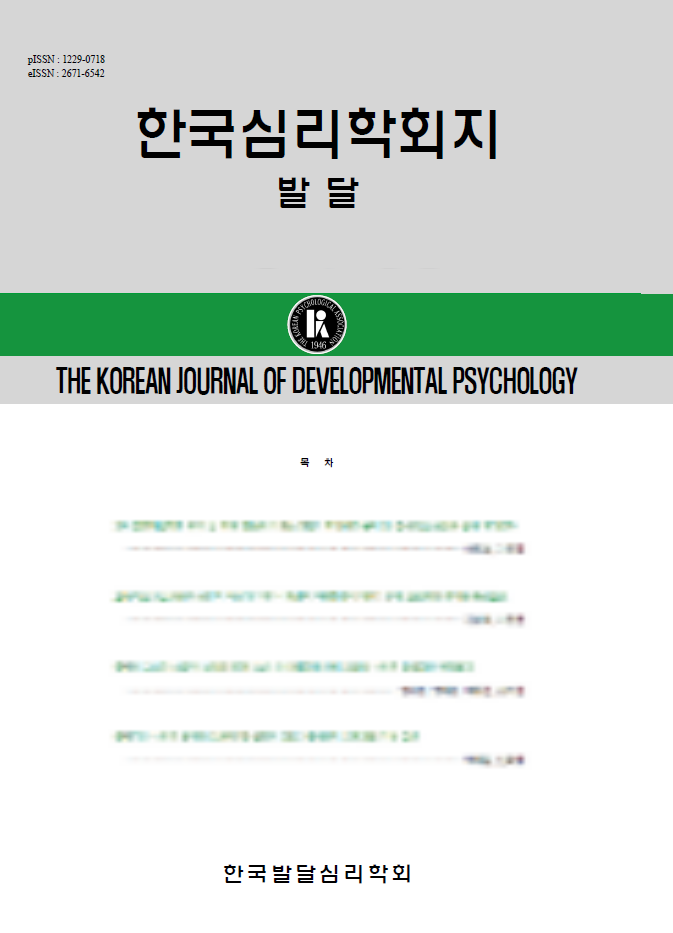open access
메뉴
open access
메뉴 ISSN : 1229-0718
ISSN : 1229-0718

만 3세 아동은 타인의 증언을 다소 맹신하는 경향을 보이나 상대의 정직성이나 지식수준을 직-간접적으로 경험하고 나면 어느 정도 이러한 경향성에서 벗어날 수 있다. 그러나 4세 아동에 비하여 3세 아동은 여전히 타인을 믿는 경향성이 큰 것으로 나타났다. 특히, 관찰 시 정직하였던 타인이 자신과의 직접 대면에서 부정직하게 행동하게 되면, 만 4세 아동은 이러한 변화에 잘 적응하여 더 이상 타인을 믿지 않게 되지만 이에 반해 만 3세 아동은 계속해서 타인의 말을 믿는 경향을 보였다. 본 연구에서는 만 3세 아동이 이와 같이 타인의 신뢰 경향성을 쉽게 극복하지 못한 원인을 두 가지 측면에서 검토하고자 하였다. 우선, 3세 아동의 어려움이 타인의 긍정적인 특질(정직)이 부정적인 특질(부정직)로 변화하였을 때에만 나타나는 것인지 살펴보았다(실험 1). 둘째, 신뢰성을 판단할 대상에 대해 또 다른 타자가 어떻게 대응하는지에 대한(예, 부정직한 사람에게 순응하는지 순응하지 않는지) 관찰이 아동의 판단과 수행에도 영향을 끼치는지 검토하였다(실험 2). 실험 결과, 만 3세 아동은 부정직하던 타인이 정직해졌을 때에도 여전히 타인을 따르는 경향을 보여 타인의 특질 변화의 방향성의 영향을 받지는 않은 것으로 보였다. 그러나 흥미롭게도 제3자적 사전 관찰 경험 시 신뢰성 판단 대상에게 타자가 순응적으로 반응하는지 아닌지는 아동의 수행에 어느 정도 영향을 끼치는 것으로 나타나 관찰 경험에서 제시된 두 사람의 특성이 3세 아동의 수행에 모두 영향을 끼칠 수 있는 것으로 나타났다.
Three-year-olds show some difficulty overcoming their bias to trust others’ testimony, especially when the informant was previously honest but became dishonest during interaction with the child. We examined two factors that might present further difficulties to children at this age: (1) whether the direction of the informant’s trait change (positive to negative versus negative to positive) has an influence on the child’s performance (Exp. 1) and (2) whether another adult’s responses to the informant in a prior observation session (Exp. 2) influences the child’s performance. The results showed that while the direction of the informant’s trait change did not affect children's performance, other adults’ responses to the informant was a somewhat influential factor in 3-year-olds’ later responses to the informant.
고연정 (2013) 신뢰성 판단에 있어서 관찰 경험활용 능력의 발달-만 3-4세 아동을 중심으로-. (국내석사학위논문, 중앙대학교 대학원)
고연정, 최영은 (2011). 만 3-4세 아동의 신뢰성 판단에 관찰 경험이 미치는 영향. 한국심리학회지 발달, 24(4), 151-162.
구재선, 김혜리, 김경미, 양혜영, 고숙남, 정명숙 (2006). 아동의 성격 특질에 대한 이해 발달: 특질 추론과 상황적, 시간적 안정성을 중심으로. 한국심리학회지 발달, 19(4), 1-20.
김윤 (2011). 만 3, 4세 아동의 거짓말 이해와 사실 추론 능력. (국내석사학위논문, 연세대학교 대학원).
서종한, 김경일 (2011). 성범죄자 군집유형분석과 프로파일링 연구. 한국심리학회지 사회 및 성격, 25(1), 155-172.
Birch, S. A. J., Vauthier, S. A., & Bloom, P. (2008). Three- and four-year-olds spontaneously use others’ past performance to guide their learning. Cognition, 107(3), 1018-1034. doi:10.1016/j.cognition.2007.12.008
Boseovski, J. J. (2010). Evidence for “Rose-colored glasses”: An examination of the positivity bias in young Children’s personality judgments. Child Development Perspectives, 4 (3), 212-218. doi:10.1111/j.1750-8606.2010.00149.x
Boseovski, J. J. (2012). Trust in testimony about strangers: Young children prefer reliable informants who make positive attributions. Journal of Experimental Child Psychology, 111(3), 543-551. doi: 10.1016/j.jecp.2011.10.008
Carlson, S. M., & Moses, L. J. (2001). Individual differences in inhibitory control and children's theory of mind. Child Development, 72, 1032-1053. doi: 10.1111/1467-8624.00333
Corriveau, K. H., Meints, K., & Harris, P. L. (2009). Early tracking of informant accuracy and inaccuracy. British Journal of Developmental Psychology, 27(2), 331-342. doi:10.1348/026151008X310229
Jaswal, V. K, Croft. A C., Setia A. R., & Cole, C. A. (2010). Young children have a specific, highly robust bias to trust testimony. Psychological Science, 21(10), 1541-7. doi: 10.1177/0956797610383438.
Jaswal, V. K., & Neely, L. A. (2006). Adults don't always know best. Psychological Science, 17(9), 757-758. doi:10.1111/j.1467-9280.2006.01778.x
Lockhart, K. L., Chang, B., & Story, T. (2002). Young children's beliefs about the stability of traits: protective optimism?. Child development. 73(5). 1408-1430. doi: 10.1111/1467-8624.00480.
Ma, L., & Ganea, P. A. (2010). Dealing with conflicting information: Young children's reliance on what they see versus what they are told. Developmental Science, 13(1), 151-160. doi:10.1111/j.1467-7687.2009.00878.x
Robinson, E. J., & Nurmsoo, E. (2009). When do children learn from unreliable speakers? Cognitive Development, 24(1), 16-22. doi:10.1016/j.cogdev.2008.08.001
Zelazo, P. D., & Frye, D. (1998). Cognitive complexity and control: II. The development of executive function in childhood. Current Directions in Psychological Science, 7(4), 121-126.
